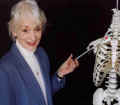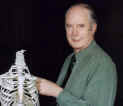 |
 |
 |
Helping You To Achieve ©™

![]()
Helping You To Achieve ©™
|
|
Identify by palpation and surface mark with a pen the Styloid Process of the Radius on a model in the anatomical position with side lighting.
Objective No 12 - Criteria to be demonstrated. 1. Request the model to flex the elbow joint to a right angle. 2. Request the model to place the forearm in a position midway between full pronation and supination with the Thumb in full extension. 3. Observe the depression when the Thumb is fully extended between the tendons of the Thumb extensors on the lateral aspect of the wrist inferior to the raised projection made by the lower extremity of the radius. 4. Place a finger tip in this depression known as the anatomical snuffbox and palpate between the extensor tendons of the Thumb moving proximally towards the expanded lower extremity of the Radius. 5. The palpating finger tip will encounter a sharp pointed process of bone. This is the Styloid process of the Radius. 6. Placing the palpating finger tip on the Styloid process of Radius, request the model to move the wrist joint in radial and ulnar deviation. 7. The Styloid process of the Radius may be identified as the Proximal row of carpal bones move and the Styloid process remains fixed.
|
Service ProvisionBronze. Students may take up a ,'Free start up ' package consisting of 100 of the behavioural objectives and criteria based on common questions asked in Living Anatomy. These are available free of charge on this Website. Silver. Students may buy a copy of the book "Surface and Living Anatomy" (ISBN: 0 7234 3261 9) which comes with a CD Rom (Windows PC format) containing 230 objectives which includes the 100 behavioural objectives contained in the Bronze Service. Gold "Helping you to Achieve" Contact Information
|